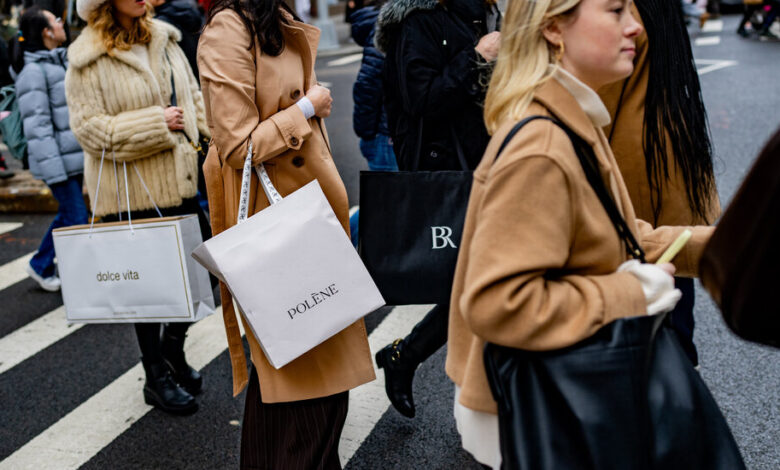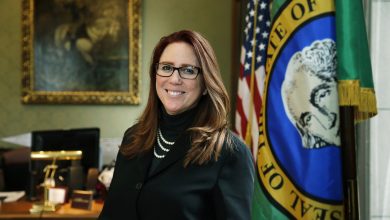What’s Going on with the U.S. Economy?

The economy is probably headed toward a recession. No, it’s actually booming again.
Inflation is plummeting. No, it has started rising again.
If you find the cacophony of economic indicators to be confusing, don’t feel bad. It is confusing. Some numbers point in one direction, while others point in the opposite. Partisans from both political parties have an interest in promoting one type of news and downplaying the other.
Yesterday’s inflation report added to the muddle. Inflation — a major concern for many families and already a 2024 campaign issue — has been falling for the past year and half. Americans’ economic mood has improved slightly as a result. But the numbers released yesterday showed inflation to be higher than forecasters had expected. In response, the S&P 500 index fell 1.4 percent, its second-biggest daily decline this year.
In today’s newsletter, I’ll give you a framework for thinking about the state of the U.S. economy by describing the four main phases of the past several years. I can’t tell you what will happen next, but I do think the picture is simpler than the swirl of economic indicators sometimes suggests.
1. The pre-Covid boom
The American economy has been disappointing for much of the past half-century. Income and wealth growth has been slow for most families, and inequality has soared. Perhaps the starkest sign of the problems: Life expectancy in the U.S. is now lower than in any other high-income country, and it isn’t especially close.
Still, there have been a few brief periods when the economy has boomed. One of them began late in Barack Obama’s presidency and continued during Donald Trump’s term. The country finally emerged from its hangover after the housing crash, as businesses expanded and consumers spent more.
The unemployment rate fell below 5 percent in 2016 and below 4 percent in 2018. The tight labor market — combined with increases in the minimum wage in many states — raised income for all income groups.
By early 2020, the U.S. economy’s short-term performance was as healthy as it had been since the dot-com boom two decades earlier.
2. The Covid crash
Then the pandemic arrived.
People stayed home and cut back on spending. Businesses laid off workers, and the unemployment rate exceeded 10 percent. Experts understandably worried that the economy could fall into a vicious cycle, in which companies went out of business, families couldn’t make loan payments and banks went under.
Many economists believed that the federal government had been too timid with stimulus after the early-2000s housing crash. During the pandemic, members of Congress vowed not to repeat the mistake and passed huge stimulus bills, which both Trump and President Biden signed.
3. The too-hot recovery
Those stimulus programs worked — a bit too well.
For all the misery that Covid caused, it ended up being less economically destructive than the housing crash. The unemployment surge was temporary. And thanks to the stimulus, the typical American family’s finances improved during the pandemic — a very different situation than the aftermath of the housing crash.
In effect, Washington overlearned the lesson of the previous crisis. It pumped so much money into the economy during the pandemic that families were able to go on a spending spree. Businesses, in response, raised prices.
The pandemic’s supply-chain disruptions played a big role, too. This combination — high demand and low supply — led to sharp price increases.
4. The healthier recovery
Once inflation rises, it can remain high for years (as it did from the late 1960s to the early 1980s). Workers demand bigger raises, and businesses, facing higher costs, raise prices even more. The dynamic is reinforcing.
When inflation soared in 2021, some economists thought the pattern was repeating. They predicted that only a deep recession would bring a return to normalcy. These dark predictions turned out to be wrong, though. Instead, inflation started falling rapidly in 2022. The end of the stimulus programs, combined with the end of most supply-chain problems, was enough to reduce price increases.
For the past several months, the economy has again looked healthy, with both employment and wages growing nicely. Yesterday’s report doesn’t change that: Annual inflation fell to 3.1 percent in January, from 3.4 percent in December. It’s just that forecasters had expected it to fall more than it did.
Why didn’t it? Maybe last month’s number was just a statistical blip. But maybe it is a sign that the economy has again become too strong for inflation to keep falling.
“Hiring picked up in January, wage growth was solid, and consumers continue to spend,” as my colleague Jeanna Smialek explains. “Some analysts have suggested that in an economy this hot, wrestling inflation the rest of the way to normal will prove more difficult than the progress so far.” Economists generally consider the ideal inflation rate to be around 2 percent.
By almost any measure, the economy is in better shape today than most forecasters predicted even a year ago. Still, it hasn’t fully recovered from the pandemic.
Related: The American economy has seen a burst of productivity recently. Read more about economists’ views on whether it will continue.
THE LATEST NEWS
Alejandro Mayorkas
-
After a crackdown on drunken driving, motorbikes are filling impound lots in Vietnam.
-
A South Korean court found three former police officers guilty of destroying evidence tied to a Halloween crowd crush that killed nearly 160 people in Seoul in 2022.
-
Two major parties in Pakistan agreed to form a coalition government. They withheld power from candidates aligned with former Prime Minister Imran Khan, even though his allies recently won the most seats.
-
Myanmar’s junta said it would impose a military draft to replenish forces that have been depleted fighting pro-democracy rebels.
-
China, faced with declining foreign investment, is trying to soften its image abroad. One Communist Party official has played a prominent role.
Other Big Stories
Opinions
As artificial intelligence takes over technical tasks, the human side of work — collaboration, empathy, communication — will become more valuable, Aneesh Raman and Maria Flynn argue.
Don’t buy flowers for your valentine. There are more environmentally friendly ways to show love, Margaret Renkl says.
The closer: When the comedian Taylor Tomlinson began her tour, she was happy with everything in her set except for her closing joke. So, over months of live shows, she refined it, adding punchlines and tweaking details. A new story by the Times comedy critic Jason Zinoman follows her through the process, showing how small changes led to big laughs.
More on culture
-
Meghan Markle has found a new podcast partner. Markle and Prince Harry’s deal with Spotify ended after they delivered just one show, Variety reports.
-
The creators of “Six,” about the six wives of Henry VIII, announced that their second musical, “Why Am I So Single?,” will premiere in London in August.
-
Paramount, which owns Nickelodeon and MTV, is laying off hundreds of employees as it moves away from traditional television.
-
Late-night hosts discussed Trump recommending Lara Trump for co-chair of the R.N.C.




